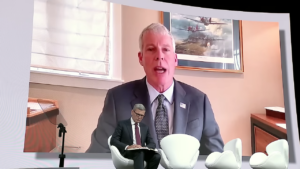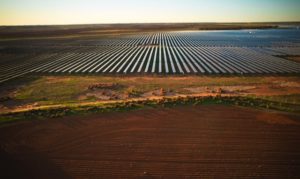Tracking fossil fuel financing
The campaign against the expansion of massive coal projects in Australia will ramp up next week with the visit of Bill McKibben, the founder of 350.org, an organisation that argues that the world’s emissions are already too high and it needs to take decisive action to wind them back. Ahead of his visit, supporting NGOs have released a new interactive map that identifies the bankers most responsible for financing coal and gas export projects along Australia’s Eastern seaboard, including in the Great Barrier Reef World Heritage Area. ANZ is fingered as the biggest lender.
The map, which can be found here, has been created by Market Forces in partnership with 350.org, and is designed to allow people to view loans to ports in specific locations and take action to communicate directly with the banks that are named. The organisations say ANZ topped the list of over 35 commercial banks, having loaned $2.35 billion to coal and gas ports from Newcastle to Abbot Point between January 2008 and May 2013. Commonwealth Bank was second on the list with $1.5 billion, followed by NAB and Westpac. The ‘big four’ Australian banks’ contributed almost a third of total project finance lending.
“The coal and gas industries are hell-bent on expanding, building a new series of export terminals in the Great Barrier Reef World Heritage Area and jeopardising our chances of keeping a lid on climate change,” Julien Vincent, Market Forces Lead Campaigner, said in a statement. “If the big banks lend to these new dirty coal and gas projects, they are taking a massive gamble with the Reef and our climate. It’s vital that customers of ANZ, Commonwealth, NAB and Westpac intervene and tell their bank to stop lending to these environmentally destructive projects.”
McKibben said the maths on avoiding the worst impacts of climate change means that there is not enough room in the carbon budget for new fossil fuel projects.” If new coal and gas projects amount to an exercise in digging up unburnable carbon, that makes the loans that enable these projects a massive economic gamble,” he said. Interestingly, one of Australia’s biggest utilities, coal and gas producer AGL Energy, earlier this week called for Australia to impose ambitious carbon budgets.
Ausgrid cancels extension
Following our story on Thursday suggesting that state-owned networks should write down the value of their investments, based on the fact that they are not being used as much as they had thought, and much of that investment may not have been required, comes news that NSW government network operator Transgrid has decided not to go ahead with a planned $200 million plus transmission line from Stround to Landsowne, north of Taree on the state’s mid north coast. The extension attracted controversy from local farmers and activists, whose campaign against the proposal reached the NSW government.
After several reviews, Transgrid at first downgraded the proposal from a 330kV line to a smaller 132kV line, and has now abandoned it completely. An independent review commissioned by the government found that demand forecasts for the extension had been hopelessly over-optimistic. It says a line extension would not be needed for at least 20 years, if at all. In the meantime, distributed generation and other cheaper alternatives would likely be sufficient.
It has been reported that the Australian Energy Market Operator estimates Transgrid has overspent on its networks by at least $1 billion. Which leads us to this thought – if the regulator can conduct a thorough review of all such investment over recent years, perhaps then the network owners can be forced to write down the value of the monies that were clearly overspent, rather than passing on the costs to consumers for the life of the asset. Oh, and good on the NSW government for taking a principled line on this. They don’t often get a gong from us. Now for the write downs!
Pedalling for sustainability
Keith Tuffley is on a mission. The retired investment banker wants to be the first recreational cyclist to complete three of the world’s toughest and most famous cycle stage races – Giro d’Italia, Tour de France, and Vuelta a Espana – on the same day as each race, this year. And to publish a daily environmental blog while he’s at it.
Starting at 5am on each of the 21 days per race, and with each race covering more than 3,300km of southern European countryside, it promises to be quite a journey – not unlike the Australian’s career path, which has led him from heading up investment banking at Goldman Sachs JBWere, to London as head of the Goldman Sachs industrials and natural resources investment banking team; and then, in retirement, to become a director of the Great Barrier Reef Foundation and Bush Heritage Australia and a governor of WWF-Australia.
Now, he aims to merge his love of cycling with his other great passion: pushing the cause of global sustainability. “This is a complex issue, and one that needs a full 63 days to cover,” Tuffley says on his Grand Tours Project blog. “For us, a sustainable future is exciting, fascinating, fun, full of opportunities – and achievable.”
Despite Tuffley’s expertise in investment banking, the idea of this project is not to raise funds, but instead to capture people’s attention long enough to raise awareness on sustainability. To this end, his blog will feature daily quotes as well as information, insights, ideas and solutions from experts – including scientists, ecologists, activists, entrepreneurs, business leaders, economists, writers, film directors, explorers and adventurers – inspiring readers to think and act differently about the environment.
Tuffley’s journey began two years ago, when he rode in the Tour de France, ahead of the competitors, just for fun. In 2012, he did the same thing with the second biggest European road race, the Giro d’Italia, but added the challenge of raising environmental awareness, as well as $21,000 for the organisations Bush Heritage Australia, Great Barrier Reef research and WWF.










